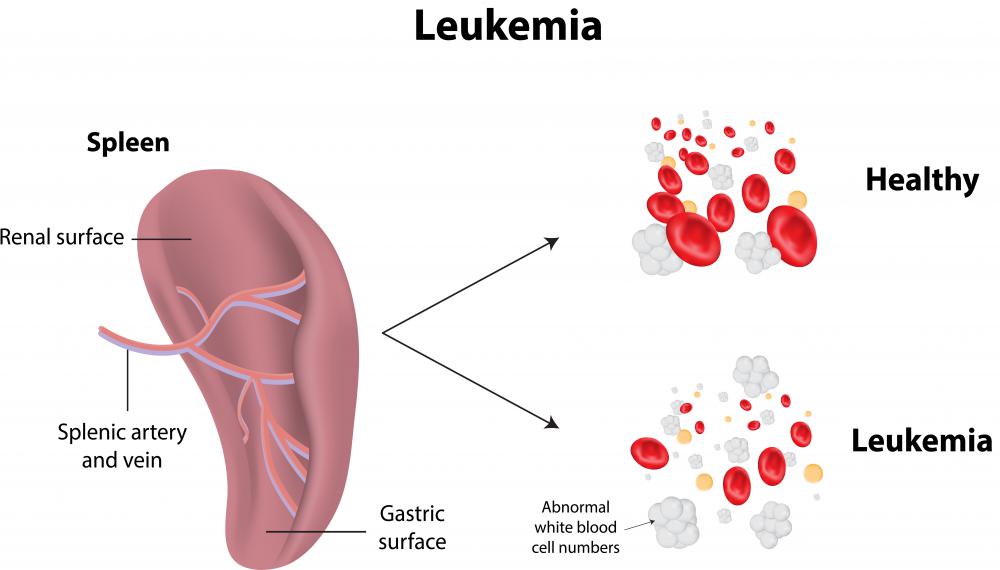At TheHealthBoard, we're committed to delivering accurate, trustworthy information. Our expert-authored content is rigorously fact-checked and sourced from credible authorities. Discover how we uphold the highest standards in providing you with reliable knowledge.
What are the Different Types of Spleen Diseases?
There are many diseases which can negatively impact the spleen, typically causing it to become enlarged, a condition known as splenomegaly. A variety of infections, including bacterial, viral, and parasitic, are frequent causes of spleen enlargement. Another of the most common spleen diseases is sickle cell disease, which can cause splenomegaly as well as asplenia, where the organ ceases to function properly. Certain types of cancers can also lead to problems with the spleen. Cysts and tumors may also form there, which can lead to enlargement and issues with correct function.
Many types of infections can become spleen diseases, leading to enlargement of the organ. One common virus that affects the spleen is the Epstein-Barr virus, which causes mononucleosis; this virus can cause splenomegaly and make the spleen more likely to rupture. Another virus that can enlarge the organ is hepatitis. Malaria, which is caused by a parasitic infection, can also negatively impact the spleen. Some bacterial infections, such as brucellosis or bacterial endocarditis, can also be to blame.

A condition that is often hard on the spleen is sickle cell disease. One of the spleen's main functions is to clear damaged cells from the blood. With this disorder, the red blood cells break easily and the spleen may become enlarged and overworked from clearing the excess debris from the bloodstream, particularly during acute attacks of the disease. Some other spleen diseases that may cause issues due to abnormally shaped blood cells include the hereditary disorders spherocytosis and elliptocytosis. It can also be the result of hemolytic anemia, a disorder in which the body's red blood cells break down and die abnormally.

Some cancers can be considered spleen diseases as well, as they can lead to splenomegaly. For example, leukemia, which leads to a significant increase in immature or abnormal blood cells in the body, can cause the spleen to become enlarged as it tries to process the blood. Certain lymphomas may negatively impact the spleen as well.
The spleen may also become enlarged or have trouble functioning if it is affected by different types of growths. Tumors may form on the spleen; they may be benign types like hemangiomas or cancerous types like hemangiosarcomas. The organ may also develop cysts. Sometimes inflammatory nodules, known as granulomas, may form there due to a condition known as sarcoidosis.
AS FEATURED ON:
AS FEATURED ON:


















Discussion Comments
I have a friend who had a car accident when we were in high school. He had his spleen removed because it was damaged during the accident. Before the accident he was a generally healthy person.
After the surgery, he started getting more colds and sore throats. This wouldn't have been so bad except that he had to go to the doctor no matter how simple the illness appeared. Can you imagine what it is like to have to go to the doctor every time you get a cold or a cough?
@Drentel - I can remember hearing those things about the spleen, too. The functions of the spleen used to be a mystery. However, as this article says, the spleen is responsible for removing damaged blood cells from the body, so this alone is reason enough to hang on to the organ.
Also, I have read that certain diseases are more likely to occur when a person has his spleen surgically taken out. After surgery patients are given vaccinations against bacteria that the spleen normally helps fight. One of the vaccinations is the vaccination for pneumonia. The spleen plays a big role in keeping the body healthy and fighting disease.
I was under the impression that the spleen doesn't have a purpose in the human body. I can remember being taught in health class that the spleen was not necessary and we could all easily live without one, and not even miss it. As I recall, we were taught that the spleen once had a function, but as humans evolved the organ had become useless and served no purpose.
Post your comments